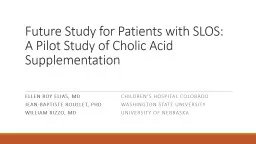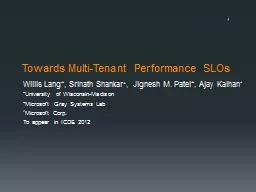PPT-Future Study for Patients with SLOS:
Author : abigail | Published Date : 2022-02-16
A Pilot Study of Cholic Acid Supplementation Ellen Roy Elias MD Childrens Hospital Colorado JeanBaptiste Roullet PhD Washington State University WILLIAM RIZZO
Presentation Embed Code
Download Presentation
Download Presentation The PPT/PDF document "Future Study for Patients with SLOS:" is the property of its rightful owner. Permission is granted to download and print the materials on this website for personal, non-commercial use only, and to display it on your personal computer provided you do not modify the materials and that you retain all copyright notices contained in the materials. By downloading content from our website, you accept the terms of this agreement.
Future Study for Patients with SLOS:: Transcript
Download Rules Of Document
"Future Study for Patients with SLOS:"The content belongs to its owner. You may download and print it for personal use, without modification, and keep all copyright notices. By downloading, you agree to these terms.
Related Documents














